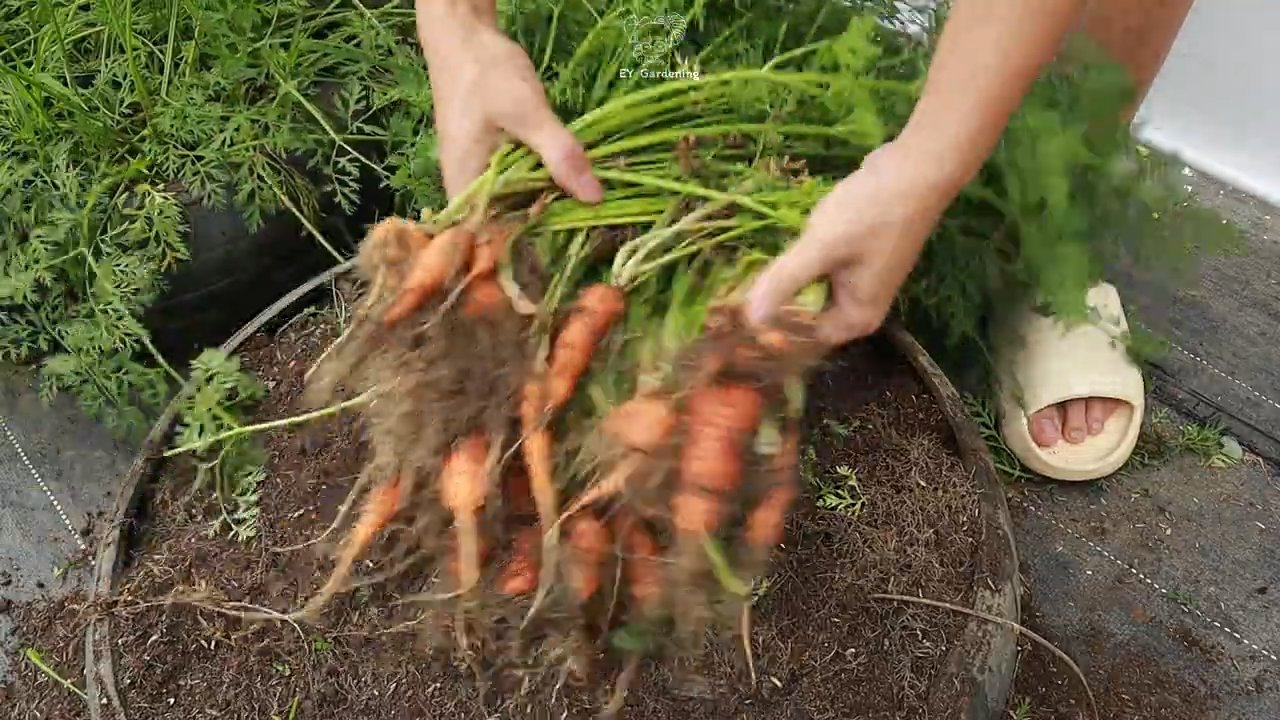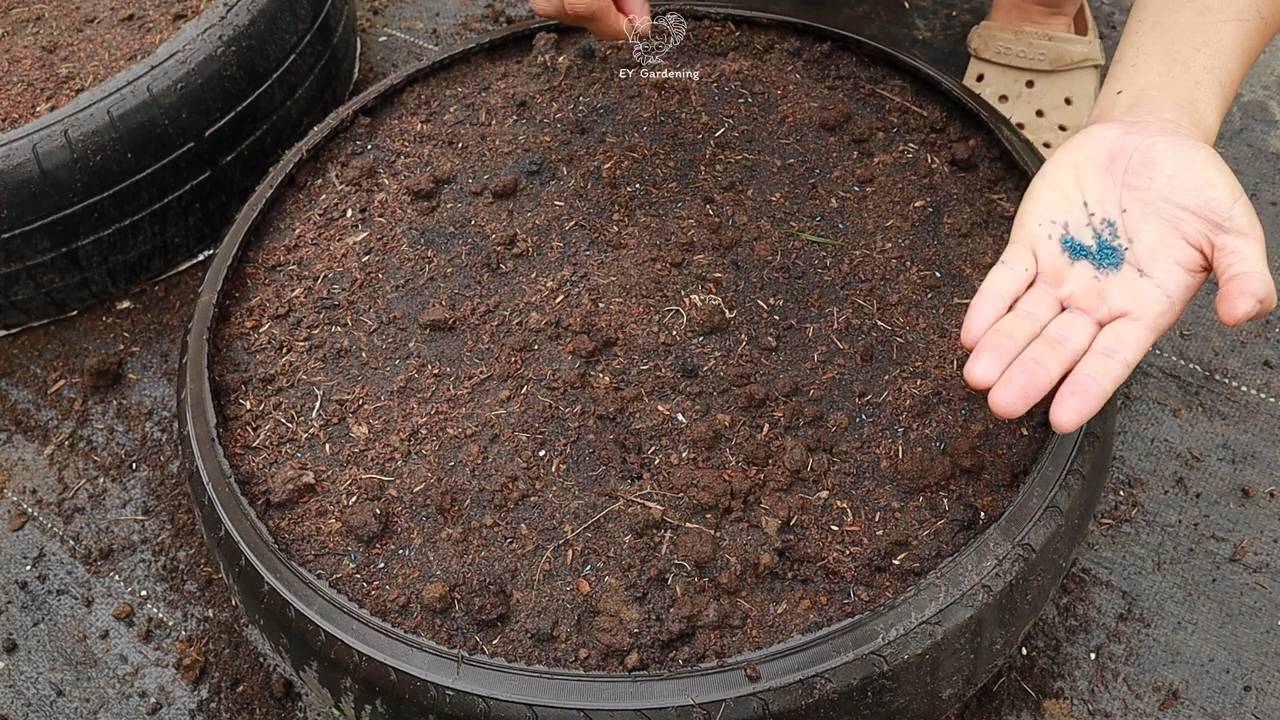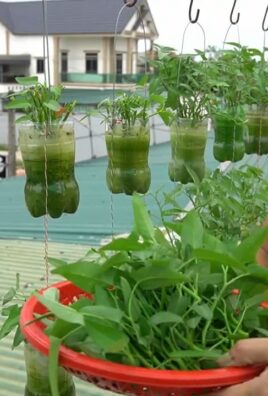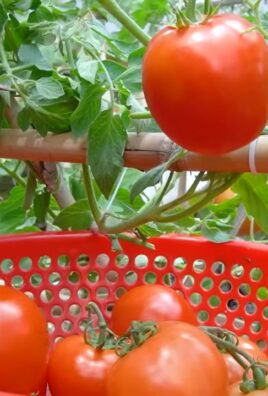Growing baby carrots at home might seem like a challenge relegated to seasoned gardeners, but I’m here to tell you it’s easier than you think! Forget those pre-packaged, often bland baby carrots from the store. Imagine plucking sweet, crisp, and perfectly petite carrots straight from your own backyard – or even a container on your balcony!
For centuries, carrots have been a staple in diets across the globe, with their vibrant color and nutritional punch. While the modern “baby carrot” as we know it is a relatively recent invention (thanks to a California farmer in the 1980s!), the desire for convenient and healthy snacks is timeless. But why settle for processed when you can cultivate your own?
This DIY guide is your secret weapon to unlocking a bountiful harvest of miniature delights. We’ll walk you through every step, from choosing the right seeds and preparing your soil to watering techniques and harvesting tips. Growing baby carrots at home not only provides you with fresh, delicious produce, but it’s also a rewarding and therapeutic experience. Plus, you’ll know exactly what’s going into your food, avoiding any unwanted chemicals or preservatives. So, grab your gardening gloves, and let’s get started on this fun and fulfilling project!

Growing Baby Carrots at Home: A Beginner’s Guide
Hey there, fellow gardening enthusiasts! Ever dreamt of plucking perfectly petite, sweet baby carrots straight from your own backyard? Well, dream no more! Growing baby carrots at home is surprisingly easy and incredibly rewarding. I’m going to walk you through everything you need to know, from choosing the right seeds to harvesting your tiny treasures. Let’s get our hands dirty!
Choosing the Right Carrot Variety
Not all carrots are created equal, especially when it comes to baby carrots. Some varieties are naturally smaller and sweeter, making them ideal for this project. Here are a few of my favorite picks:
* ‘Thumbelina’: These are round, almost golf-ball shaped carrots that are incredibly cute and perfect for small spaces.
* ‘Parisian’: Similar to ‘Thumbelina,’ these are also round and mature quickly.
* ‘Little Finger’: As the name suggests, these are small, slender carrots that are sweet and tender.
* ‘Short n Sweet’: A classic choice for baby carrots, known for its sweetness and compact size.
* ‘Adelaide’: Another great option for shorter, sweeter carrots.
Pro Tip: Always check the seed packet for information on carrot size and maturity time. Baby carrots typically mature faster than full-sized varieties.
Preparing Your Garden Bed
Carrots need loose, well-drained soil to thrive. Rocky or compacted soil can lead to misshapen or stunted carrots. Here’s how I prepare my garden bed for baby carrots:
* Choose a Sunny Spot: Carrots need at least 6 hours of sunlight per day.
* Clear the Area: Remove any rocks, weeds, or debris from the planting area.
* Loosen the Soil: Use a garden fork or tiller to loosen the soil to a depth of at least 12 inches. This is crucial for proper root development.
* Amend the Soil: Incorporate plenty of compost or well-rotted manure into the soil. This will improve drainage, fertility, and soil structure.
* Create Raised Beds (Optional): Raised beds can improve drainage and make it easier to control the soil quality. I often use them, especially in areas with heavy clay soil.
* Smooth the Surface: Rake the soil to create a smooth, even surface. This will make it easier to sow the seeds evenly.
Important Note: Avoid using fresh manure, as it can cause forking and hairy roots.
Sowing the Carrot Seeds
Carrot seeds are tiny, so sowing them evenly can be a bit tricky. Here’s my method for getting the best results:
1. Create Shallow Furrows: Use a trowel or your finger to create shallow furrows about 1/4 to 1/2 inch deep and 1-2 inches apart.
2. Sow the Seeds: Sprinkle the seeds thinly along the furrows. Try to space them about 1/2 inch apart. Don’t worry if you sow them too thickly; you can always thin them later.
3. Cover the Seeds: Gently cover the seeds with a thin layer of soil.
4. Water Gently: Use a watering can with a gentle rose or a hose with a spray nozzle to water the soil thoroughly. Be careful not to wash away the seeds.
5. Keep the Soil Moist: Carrot seeds need consistent moisture to germinate. Water the soil regularly, especially during dry spells. I check the soil moisture daily and water when the top inch feels dry.
Seed Tape Trick: If you struggle with sowing tiny seeds evenly, consider using seed tape. Seed tape contains pre-spaced seeds embedded in a biodegradable tape. Simply lay the tape in the furrow, cover with soil, and water.
Thinning the Seedlings
Thinning is essential for giving your baby carrots enough space to grow. If the seedlings are too crowded, they will compete for resources and produce smaller, less flavorful carrots.
1. Wait Until Seedlings Emerge: Wait until the seedlings are about 1-2 inches tall before thinning.
2. Thin to 1-2 Inches Apart: Carefully pull out the weaker seedlings, leaving the strongest ones spaced about 1-2 inches apart.
3. Water After Thinning: Water the soil after thinning to help the remaining seedlings settle in.
Don’t Waste the Thinnings: You can eat the carrot thinnings! They are tender and have a mild carrot flavor. Add them to salads or use them as a garnish.
Caring for Your Carrot Plants
Once your carrot seedlings are established, it’s important to provide them with the right care to ensure a bountiful harvest.
* Watering: Water regularly, especially during dry spells. Carrots need consistent moisture to develop properly. Aim for about 1 inch of water per week.
* Weeding: Keep the garden bed free of weeds. Weeds compete with carrots for nutrients and water. Hand-pull weeds carefully to avoid disturbing the carrot roots.
* Fertilizing: Carrots are not heavy feeders, but they benefit from a light feeding of fertilizer. Use a balanced fertilizer or a fertilizer specifically formulated for root vegetables. Follow the instructions on the fertilizer package. I like to use a liquid seaweed fertilizer diluted in water every few weeks.
* Mulching: Apply a layer of mulch around the carrot plants. Mulch helps to retain moisture, suppress weeds, and regulate soil temperature. Straw, shredded leaves, or wood chips are good choices for mulch.
Pest Control: Carrots can be susceptible to certain pests, such as carrot rust flies and aphids. Inspect your plants regularly for signs of pests and take action if necessary. Organic pest control methods, such as insecticidal soap or neem oil, can be effective.
Harvesting Your Baby Carrots
The best part! Baby carrots are typically ready to harvest in 50-70 days, depending on the variety. Here’s how to tell when they’re ready and how to harvest them:
1. Check the Size: Baby carrots are usually harvested when they are about 3-4 inches long and 1/2 to 1 inch in diameter.
2. Loosen the Soil: Gently loosen the soil around the carrots with a garden fork or trowel.
3. Pull the Carrots: Grasp the carrot tops firmly and gently pull the carrots out of the soil. If the soil is dry, water it before harvesting to make it easier to pull the carrots.
4. Wash and Enjoy: Wash the carrots thoroughly and enjoy them fresh from the garden!
Succession Planting: To enjoy a continuous harvest of baby carrots, sow seeds every 2-3 weeks throughout the growing season.
Troubleshooting Common Problems
Even with the best care, you may encounter some problems when growing baby carrots. Here are a few common issues and how to address them:
* Poor Germination: If your carrot seeds are not germinating well, it could be due to several factors, such as old seeds, dry soil, or cold temperatures. Use fresh seeds, keep the soil consistently moist, and wait for warmer weather.
* Forked Roots: Forked roots are often caused by rocky or compacted soil. Prepare your garden bed carefully and remove any rocks or debris. Avoid using fresh manure.
* Hairy Roots: Hairy roots can be caused by excessive nitrogen in the soil. Avoid over-fertilizing your carrots.
* Pests: Inspect your plants regularly for signs of pests and take action if necessary. Organic pest control methods are often effective.
* Bolting: Bolting (premature flowering) can occur if carrots are exposed to extreme temperatures or stress. Provide consistent watering and protect your plants from extreme weather.
My Secret Weapon: I always add a handful of sand to the furrow when planting carrot seeds. It helps to improve drainage and prevent the soil from crusting over, which can hinder germination.
Storing Your Harvest
If you have more baby carrots than you can eat fresh, you can store them in the refrigerator for several weeks.
1. Wash and Dry: Wash the carrots thoroughly and dry them completely.
2. Store in a Plastic Bag: Place the carrots in a plastic bag with a few paper towels to absorb excess moisture.
3. Refrigerate: Store the bag in the refrigerator crisper drawer.
Freezing Carrots: You can also freeze carrots for longer storage. Blanch the carrots in boiling water for 2-3 minutes, then plunge them into ice water to stop the cooking process. Drain the carrots and freeze them in a single layer on a baking sheet. Once frozen, transfer them to a freezer bag or container.
Enjoying Your Homegrown Baby Carrots
Now that you’ve successfully grown your own baby carrots, it’s time to enjoy the fruits (or rather, vegetables) of your labor! Here are a few of my favorite ways to use homegrown baby carrots:
* Snack on Them Raw: Baby carrots are delicious and nutritious as a snack. Dip

Conclusion
So, there you have it! Growing baby carrots at home is not only achievable, but it’s also a deeply rewarding experience. Forget those pre-packaged, often bland, supermarket versions. Imagine biting into a sweet, crisp, and perfectly sized baby carrot that you nurtured from seed to harvest. The difference in flavor and texture is truly remarkable. This DIY project transforms a simple vegetable into a culinary delight and a source of immense personal satisfaction.
But the benefits extend beyond just taste. By growing your own baby carrots, you gain complete control over what goes into your food. You can avoid harmful pesticides and herbicides, ensuring that you’re feeding yourself and your family the healthiest possible produce. Plus, gardening is a fantastic stress reliever and a great way to connect with nature. It’s a win-win situation!
Don’t be afraid to experiment with different varieties of carrot seeds. Nantes and Chantenay types are particularly well-suited for growing baby carrots due to their shorter length and cylindrical shape. You can also try planting them in succession, sowing a new batch of seeds every few weeks, to ensure a continuous harvest throughout the growing season. Consider adding companion plants like radishes or onions to deter pests and improve soil health.
Another fun variation is to grow rainbow baby carrots! Seed mixes containing purple, yellow, and white carrots add a vibrant splash of color to your garden and your plate. They’re a great way to get kids excited about eating their vegetables.
We understand that gardening can sometimes seem daunting, but growing baby carrots is surprisingly easy, even for beginners. With a little patience, attention to detail, and the tips we’ve shared, you’ll be harvesting your own delicious baby carrots in no time.
We wholeheartedly encourage you to give this DIY trick a try. It’s an investment in your health, your taste buds, and your overall well-being. And once you’ve tasted the difference between homegrown and store-bought, you’ll never go back.
We’re eager to hear about your experiences! Share your photos, tips, and challenges in the comments below. Let’s create a community of baby carrot enthusiasts and inspire others to embrace the joys of homegrown goodness. Happy gardening!
Frequently Asked Questions (FAQ)
What kind of soil is best for growing baby carrots?
Baby carrots thrive in loose, well-drained soil that is rich in organic matter. Avoid heavy clay soils, as they can restrict root growth and result in misshapen carrots. Amend your soil with compost or well-rotted manure to improve drainage and fertility. A slightly acidic soil pH of 6.0 to 6.8 is ideal. Before planting, make sure to remove any rocks or debris that could hinder the development of the carrots.
How much sunlight do baby carrots need?
Baby carrots require at least six hours of direct sunlight per day to grow properly. Choose a sunny location in your garden that receives ample sunlight throughout the day. If you live in a particularly hot climate, some afternoon shade can be beneficial to prevent the soil from drying out too quickly.
How often should I water my baby carrots?
Consistent watering is crucial for growing healthy baby carrots. Keep the soil consistently moist, but not waterlogged. Water deeply whenever the top inch of soil feels dry to the touch. Avoid overhead watering, as it can promote fungal diseases. Instead, use a soaker hose or drip irrigation system to deliver water directly to the roots.
When is the best time to plant baby carrots?
The best time to plant baby carrots depends on your climate. In cooler regions, you can plant them in early spring as soon as the soil is workable. In warmer regions, you can plant them in late summer or early fall for a winter harvest. Avoid planting during the hottest months of the year, as high temperatures can inhibit germination and growth.
How long does it take for baby carrots to mature?
Baby carrots typically mature in 50 to 70 days, depending on the variety and growing conditions. You can start harvesting them when they reach the desired size, usually around 3 to 4 inches long. To check for ripeness, gently loosen the soil around the base of a carrot and pull it out. If it’s the right size and color, you can harvest the rest.
What are some common pests and diseases that affect baby carrots?
Some common pests that can affect baby carrots include carrot rust flies, aphids, and nematodes. To prevent pest problems, practice crop rotation, use row covers, and introduce beneficial insects like ladybugs. Common diseases that can affect baby carrots include leaf blight and root rot. To prevent disease problems, ensure good air circulation, avoid overhead watering, and use disease-resistant varieties.
Can I grow baby carrots in containers?
Yes, you can absolutely grow baby carrots in containers! Choose a container that is at least 8 inches deep and has drainage holes. Fill the container with a well-draining potting mix and plant the seeds according to the instructions on the seed packet. Keep the soil consistently moist and fertilize regularly with a balanced fertilizer. Container-grown baby carrots may require more frequent watering than those grown in the ground.
How do I prevent my baby carrots from splitting?
Splitting can occur when baby carrots experience inconsistent watering. To prevent splitting, ensure that the soil remains consistently moist, especially during dry periods. Avoid overwatering after a period of drought, as this can cause the carrots to absorb too much water too quickly.
What are some good companion plants for baby carrots?
Good companion plants for baby carrots include radishes, onions, garlic, rosemary, and marigolds. Radishes help to break up the soil and deter pests, while onions and garlic repel carrot rust flies. Rosemary and marigolds also deter pests and attract beneficial insects.
How do I store baby carrots after harvesting?
To store baby carrots after harvesting, remove the tops and wash them thoroughly. Pat them dry and store them in a plastic bag or container in the refrigerator. They should last for several weeks. You can also freeze baby carrots for longer storage. Blanch them in boiling water for a few minutes, then transfer them to an ice bath to stop the cooking process. Drain them well and store them in freezer bags.




Leave a Comment